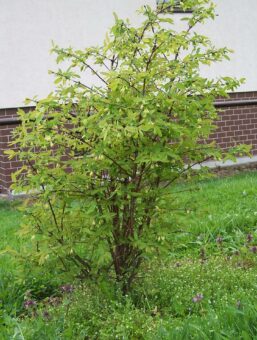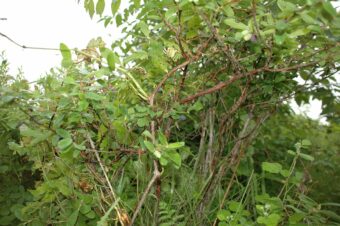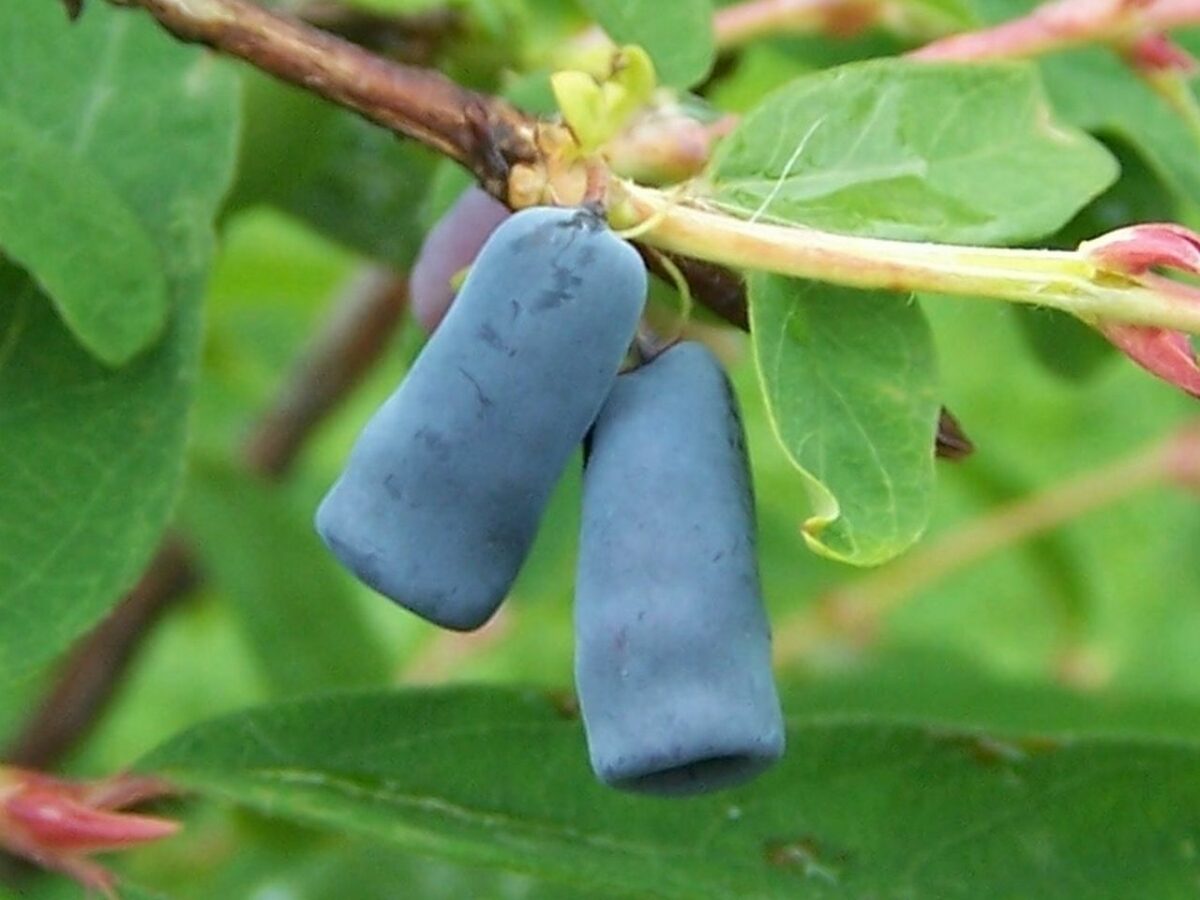In this article, we will be discussing how to grow honeyberries in containers. We have all become accustomed to growing blueberries in our gardens, where most of us grow them in containers.

This is because it is easier to control the growing media the plant is grown in, as they prefer ericaceous compost. It is not easy to grow blueberries in the garden, as they have too many demands.
A plant that is similar but easier to grow is honeyberries or haskap as it is alternatively known. Is it worthwhile in growing this fruit bush in containers, well find out by reading on?
WHAT ARE HONEYBERRIES?
Its Latin name is Lonicera caerulea but it has a common name of Blue Honeysuckle, Haskap, Sweetberry Honeysuckle, Fly Honeysuckle, Blue-Berried Honeysuckle, or Honeyberry.
It is a non-climbing or bush honeysuckle that grows in very cool climates, especially in the northern hemisphere. It grows very well in countries like Canada, Japan, Poland and Russia and you can imagine, it is a very hardy plant that can take harsh frosts.
Honeyberry is a deciduous shrub that grows up to 2m in height. It has oval, small, green leaves that are broad and have a slightly waxy texture. In early spring, it produces long, yellow-white flowers that are produced in pairs on the same shoot.
The sweet edible fruits are either rectangular in shape or they can be rounded. A typical mature bush will produce up to 3 kg of fruit and so is well worth the effort.
THEY ARE NOT BLUEBERRIES
At first glance, they look like a squashed blueberry (and hence why it is often compared to blueberries) but the flavour is hard to describe- very potent to my personal taste. It tastes like a mixture of strong honey and sourness.

One thing about honeyberries is that they are easy to grow. All they need is full sun, a well-drained growing media and the right amount of water and fertilisation. They will tolerate light shade but the yield will not be as high.
This is one plant that needs good drainage to avoid the roots from rotting. Honeyberries like good air circulation around its branches and leaves, as the plant likes to be cooled down. To help achieve good circulation through the plant, you will need to prune it so that any inward or crossing branches are cut out. It is best to prune after the plant has flowered, as you will not lose fruits.
PLANTING YOUR HONEYBERRY IN CONTAINERS
Initially, it is not necessary to use a large container, as the vacant space in the container will be wasted.
Choose a container that is at least 4cm in diameter larger than the container it came in. Fill it up with a well-drained, multipurpose compost with John Innes number 3. Make a hole in the centre about the size of the root ball of the original plant. Firm it in and then backfill any vacant spaces, so that the plant is firmly situated in the container. When planting make sure that the top of the root ball is at the same level it was in the original container.
Water well and continue to water well until it is well established. After 2 to 3 years and once it has become root bound, you will need to pot on to the next available pot size up. Your plant will be happy that you did, as it hates to be root bound.
SUNLIGHT IS IMPORTANT
Honeyberries need 6 to 8 hours of sunlight to do well, but in this condition, the leaves can get sunscald. It is advised to offer some shade from the midday sun. This can be achieved by using a screen or by moving the container to a spot where it is protected from the noon sun.
The only care that is required in spring is an annual feed with a slow-release fertiliser to give a boost through the growing season. It is a plant that prefers to grow in moist compost and plants in containers will need more moisture than those grown in the ground. Water well but do not waterlog the plant.
WATCH OUT FOR THE BIRDS
One of the biggest pest for container-grown fruits will be the birds. Once the fruits are ripe in May or June and unless you protect them. They will be all gone in a day or two, as they desire the sweet fruits.

To prevent this, you will need to use some netting as this will make sure your harvest will be protected. One other consideration that must be considered and is recommended, is that you need to grow two different varieties of honeyberries close proximity to each other to get a decent crop.
Pruning is recommended but this is not necessary to get the bushes to fruit. It will do so regardless. It is best to prune out dead branches, crossing branches and those that are overcrowded. You need to create a good, open structure in the centre as this will help to cool the plant and also reduce any fungal diseases the plant can suffer from.
USES OF HONEYBERRY
It can be used to make jams and jellies; it can be used as a pie filler and can be used to make a fruit wine.
Honeyberries can be easily raised from seed but this is not recommended as it will take a while for the fruit to be formed. All you need to do is remove the seeds from the fruit and pulp and then sow them in a moist and warm seed compost during the summer. It will take a while but soon you will have a viable, fruiting plant.
WHAT VARIETIES SHOULD BE GROWN
There are some varieties, all having a different taste, so sweeter, some sourer. The best varieties to eat are Lonicera caerulea var. edulis and L. caerulea var. kamtschatica.
Lonicera Caerulea var. edulis produces elongated, burgundy red and sweet-tasting fruits, whilst Lonicera caerulea var. kamtschatica, on the other hand, produces longer elongated fruits and tends to be sweeter. Both varieties do not taste like each other and are noticeably different.
Varieties to grow includes ‘Eisbar‘ and ‘Balalaika’
CONCLUSIONS
In this article, we have discussed the best way to grow honeyberries in containers. They are easy to grow and to fruit and makes a great alternative to the often grown blueberries.
You will need two varieties that I recommend to get a decent crop. Although they are self-fertile, two varieties will increase your yields.
All you need to do is repot every 3 years, water regularly especially in hot weather, and feed once a year in early spring. A prune will not go amiss, but it is not necessary. So remember to protect your harvest from those hungry birds, but if you look after right you can produce up to 3kg of fruit.
If you have any questions or comments that you wish to make, please do so in the comment box below.
Happy honeyberry growing.


Honeyberries are one of my favourite berries ever but I didn’t know that it is possible to grow them in containers. Wow, this is good for me to learn and I’m sure I would like to give this a try soon. The tips you have about how to grow them are really explanatory and I don’t think that I should have a problem growing it.
Hi Jackie
I always recommend that you give it a go, as you never know if you are going to succeed if you do not try it in the first place. Honeyberries are such a different fruit with their taste being hard to describe. I am glad you like them and think about growing it yourself.
Thanks
Antonio
Thanks a lot for this helpful article, I always find your articles really nice and very resourceful to have because they help me a lot when it comes to me growing my garden, most especially containers. Growing honeyberries is gonna be a great idea and it’s thoughtful of you to share this procedures.
Hi Jbryce
Thank you for the compliment. as it makes my job worthwhile. Honeyberries are growing in popularity and I hope that you apply what I write to your own container grow specimen.
Good luck
Antonio
Thank you for this insightful method of as you have described how to grow them in great details and in easy to understand way. I felt the birds will not be an issue but am glad you pointed this out. This will go along way to avoid losing all my efforts to birds. I am thinking of using a scarecrow alongside with my human presence during May and June to scare them away. I hope it works
Hi Parmeter
I thank you for those kind words, as it was such a joy in writing this article that can help you to grow honeyberries in containers easily. Birds can be an issue but if you offer the right protection that you will be soon harvesting a bountiful crop.
Thanks
Antonio